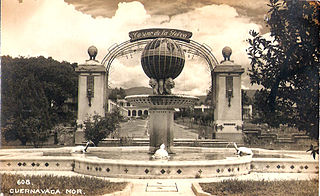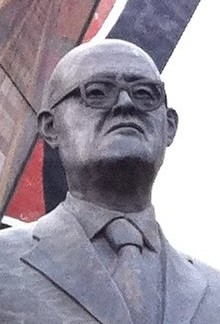
David Alfaro Siqueiros was a Mexican social realist painter, best known for his large public murals using the latest in equipment, materials and technique. Along with Diego Rivera and José Clemente Orozco, he was one of the most famous of the "Mexican muralists". He was a member of the Mexican Communist Party, and a Stalinist and supporter of the Soviet Union who led an unsuccessful attempt to assassinate Leon Trotsky in May 1940.

José Clemente Orozco was a Mexican caricaturist and painter, who specialized in political murals that established the Mexican Mural Renaissance together with murals by Diego Rivera, David Alfaro Siqueiros, and others. Orozco was the most complex of the Mexican muralists, fond of the theme of human suffering, but less realistic and more fascinated by machines than Rivera. Mostly influenced by Symbolism, he was also a genre painter and lithographer. Between 1922 and 1948, Orozco painted murals in Mexico City, Orizaba, Claremont, California, New York City, Hanover, New Hampshire, Guadalajara, Jalisco, and Jiquilpan, Michoacán. His drawings and paintings are exhibited by the Carrillo Gil Museum in Mexico City, and the Orozco Workshop-Museum in Guadalajara. Orozco was known for being a politically committed artist, and he promoted the political causes of peasants and workers.

The World Trade Center Mexico City, commonly known by its former name, Hotel de México, is a building complex located in the wealthy neighborhood of Colonia Nápoles in central Mexico City. Its most famous and recognizable feature is the 50-story, 207 metres (679 ft) high Torre WTC, the biggest building in the local area. It is the third tallest building in Mexico City when including antenna, and at its roof height, it stands 191 metres (627 ft).
Roberto Guardia Berdecio was a Bolivian-born artist and a significant contributor to the important political and cultural art movement in Mexico during the 1950s and 1960s.

Mexican Muralism refers to the art project initially funded by the Mexican government in the immediate wake of the Mexican Revolution (1910-1920) to depict visions of Mexico's past, present, and future, transforming the walls of many public buildings into didactic scenes designed to reshape Mexicans' understanding of the nation's history. The murals, large artworks painted onto the walls themselves had social, political, and historical messages. Beginning in the 1920s, the muralist project was headed by a group of artists known as "The Big Three" or "The Three Greats". This group was composed of Diego Rivera, José Clemente Orozco and David Alfaro Siqueiros. Although not as prominent as the Big Three, women also created murals in Mexico. From the 1920s to the 1970s, many murals with nationalistic, social and political messages were created in many public settings such as chapels, schools, government buildings, and much more. The popularity of the Mexican muralist project started a tradition which continues to this day in Mexico; a tradition that has had a significant impact in other parts of the Americas, including the United States, where it served as inspiration for the Chicano art movement.

Luis Arenal Bastar was a Mexican painter, engraver and sculptor. He was a founding member of the Liga de Escritores y Artistas Revolucionarios, the Taller de Gráfica Popular and the Salón de la Plástica Mexicana. In addition, he created murals and other monumental works in Mexico City and Guerrero.
Amado de la Cueva was a Mexican painter. De la Cueva studied in Rome. After his return to Mexico in September 1922, he painted amongst others together with Diego Rivera his murals at the Secretaría de Educación Pública. On October 16, 1923, he returned to his home town, where he painted the murals at Universidad de Guadalajara's assembly hall together with David Alfaro Siqueiros and Carlos Orozco after 1925.

The Centro Urbano Benito Juárez, more commonly called the Multifamiliar Juárez, was a large apartment complex built on the southeast section of Colonia Roma, Mexico City in the late 1940s and early 1950s. It was one of several projects of this type by architect Mario Pani, designed to be semi-autonomous and incorporate as much outdoors space as possible. It also featured one of the largest mural works of the 20th century by artist Carlos Mérida. Most of the complex, and the mural work with it, were destroyed by the 1985 Mexico City earthquake and the demolition of many of the damaged buildings. Only a few of the original buildings still remain. Despite this, the Cuauhtémoc borough in which it is located still lists it as a separate colonia or neighborhood.

Leopoldo Méndez was one of Mexico's most important graphic artists and one of that country's most important artists from the 20th century. Méndez's work mostly focused on engraving for illustrations and other print work generally connected to his political and social activism. His most influential work was connected to organizations such as the Liga de Escritores y Artistas Revolucionarios and the Taller de Gráfica Popular creating propaganda related to the ideals of the Mexican Revolution and against the rise of Fascism in the 1930s. Despite his importance in 20th-century artistic and political circles, Méndez was a relatively obscure figure during his life, and remains so afterwards. The reasons for this generally relate to the fact that he believed in working collaboratively and anonymously for the good of society rather than for monetary gain and because the socialist and communist themes of his work fell out of favor with later generations. Despite this, he has received some posthumous recognition with Mexican scholarship considering him to be the successor to graphics artist José Guadalupe Posada.

Guillermo Ceniceros is a Mexican painter and muralist, best known for his mural work in Mexico City, as well as his figurative easel work. He began his mural painting career as an assistant to mural painters such as Federico Cantú, Luis Covarrubias and then David Alfaro Siqueiros who was a mentor and a key influence. Ceniceros is the most notable of Siqueiros' assistants. While he has experimented with abstract expression, his easel work mostly classifies as figurativism and is influenced by the geometrical construct of Mexican muralism. He has had over 300 individual and collective exhibitions in Mexico and the International stage. His work has been recognized by the Mexican Ministry of Culture and several of its institutions. He has painted over 20 large scale Mural Paintings with some of the most notable being the large scale work for the Legislative Palace of San Lazaro as well as his murals in the Metro Subway System. He is a member of the Salón de la Plástica Mexicana. In 1995, the State of Durango, Ceniceros' native state, opened to the public the Guillermo Ceniceros Art Museum within the oversight of the Ministry of Culture. Ceniceros has been reviewed by notable critics such as Berta Taracena, Raquel Tibol, Alaide Foppa, Graciela Kartofel, José Angel Leyva and Eduardo Blackaller among others. There are several publications about his work including a vast review of his art life endeavors developed by the Ministries of Culture of Durango and Nuevo León. He is married to the artist Esther González and lives in his studio house in the Colonia Roma of Mexico City.
Mario Orozco Rivera was a Mexican muralist and painter, a later proponent of Mexican muralism, and whose work was particularly influenced by David Alfaro Siqueiros. He created a number of murals, mostly in the state of Veracruz before becoming an assistant to Siqueiros, directing the Taller Siqueiros in Cuernavaca and working with the artists on projects such as the Polyforum Cultural Siqueiros. While preferring mural work, which he considered less commercial, Orozco Rivera also created oils and sculptures. Many of these works were exhibited in Mexico and abroad and can be found in many major collections. His work received recognition in various countries.

Colonia Nápoles is a colonia, is an officially recognized neighborhood in Benito Juárez borough, Mexico City, and one of the iconic Mid-Century neighborhoods of Mexico City along with Colonia Del Valle.

The History of Mexico is a mural in the stairwell of the National Palace in Mexico City by Diego Rivera. Produced between 1929 and 1935, the mural depicts Mexico's history from ancient times to the present, with particular emphasis on the struggles of the common Mexican people fighting against the Spanish, the French, and the dictators that controlled the country at different points in its history.

Zapata (1932) is a lithograph by the Mexican artist Diego Rivera (1886–1957) that depicts the Mexican revolutionary Emiliano Zapata (1879–1919) as he holds the reins of a horse among a group of campesinos (peasants). The lithographic edition was created and printed twelve years after Zapata's assassination. Zapata is based on Agrarian Leader Zapata (1931), one of eight "portable" frescoes produced explicitly for Rivera's solo exhibition at the Museum of Modern Art (MoMA) in 1931, which was adapted from his previous Revolt panel from a fresco titled The History of Cuernavaca and Morelos (1929–30) painted in the Palace of Cortés, Cuernavaca. There were 100 original prints of the lithograph, many of which are in the collections of various art museums.
La Tallera used to be David Alfaro Siqueiros' workshop, and in recent years it has become one of the most important art spaces in Mexico. It is located in the city of Cuernavaca, Morelos. In the artist's own words: "the space was born of an idea that Diego Rivera and I had since 1920, that is, the creation of a real workshop for Mural Painting; here the different techniques, materials, paintings, perspectives and geometric aspects will be rehearsed".
Arturo Moyers Villena was a Mexican muralist and painter, whose work was influenced by David Alfaro Siqueiros. Many of his mural works are exhibited in government buildings or cultural institutions.

The Hotel Casino de la Selva was a hotel and casino located in the city of Cuernavaca, Mexico. The main building was opened in 1931 as a hotel and casino, but from 1934 it was used only as a hotel. Additions in the late 1950s included buildings designed by the architect Félix Candela that were roofed by reinforced concrete paraboloid shells. The interior was decorated with murals by well-known Mexican and Spanish artists. After the 1970s the hotel went into decline, and in 1994 was sold to a hotel chain that failed to pay taxes on the property. It was seized by the Mexican government and was auctioned off in 2001 as a site for construction of a discount store and a hypermarket. After demolition had begun there was a public outcry, and eventually some parts of the murals were preserved.

Manuel Suárez y Suárez was a Spanish immigrant to Mexico who became a successful entrepreneur and patron of the arts. He is known for the Casino de la Selva in Cuernavaca, the Hotel de México, and the adjacent Polyforum Cultural Siqueiros.

The Hotel de México was to have been the largest hotel in the Americas, a huge project started by the entrepreneur Manuel Suárez y Suárez in 1966 in Mexico City, Mexico. The project ran out of control and was never completed. After Suárez died in 1987 it stood unfinished for several years before being converted into an office building named the World Trade Center.
Electa Arenal, born as Elena Electa Arenal y Huerta, was a Mexican artist, known best as a muralist painter, and sculptor.















